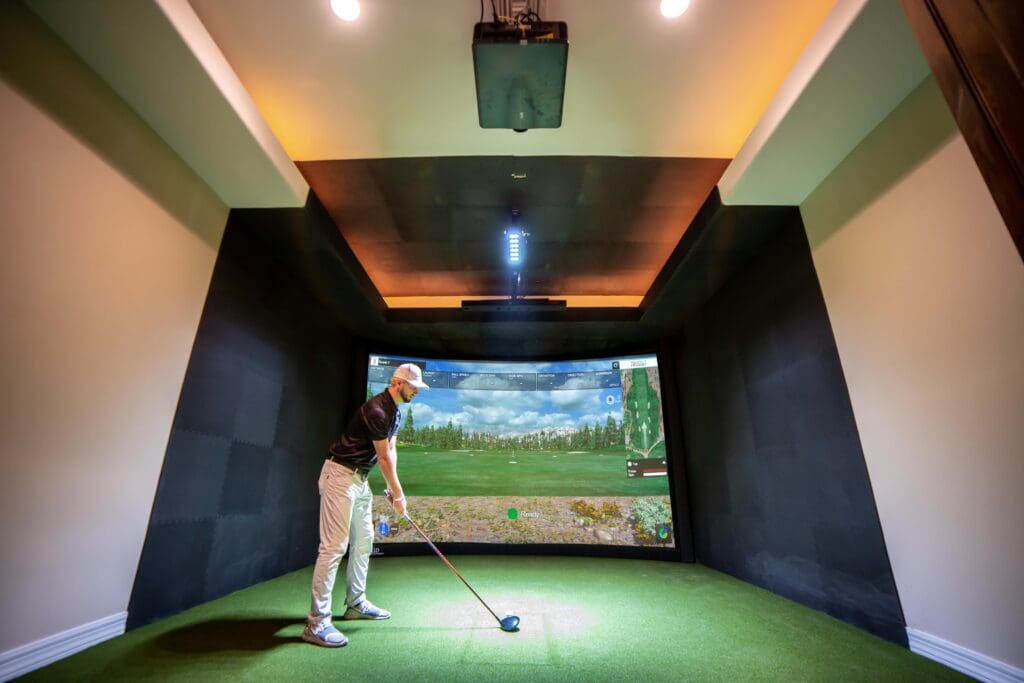How Do Golf Simulators Calculate Spin?
High-speed cameras and intricate sensors spring into action when you strike the ball in a golf simulator. They meticulously capture every little detail of the ball as it contacts the club face. They’re looking for how the ball spins—this includes both the spin rate and its axis. Why does this matter? How the ball spins will shape its flight path and, ultimately, determine where it lands. But there’s more to it. The sensors also keep an eye on the club’s path and the angle of its face at the moment of impact. This gives you a wealth of feedback about your swing dynamics.
Understanding Spin in Golf

Spin does make a world of difference in golf. It’s what shapes your shot’s trajectory and curve. When you strike the ball, its spin is influenced by the club you’ve chosen, the angle of the club face at impact, and your swing speed. Whether it results in a frustrating slice or an impressive hook, it all comes down to how the ball spins off your club.
Let’s talk about the spin axis—it’s a game-changer. Picture an invisible line running from the top of the ball to the bottom as it flies. This is your spin axis. How this axis tilts, known as the spin axis value, decides whether your ball will draw or fade. A positive spin axis value for right-handers means the ball will fade to the right, whereas a negative value sends it left for a draw.
Understanding the interaction between spin, the axis, and the club can transform your game. Different clubs affect these elements uniquely. For instance, drivers generally produce more spin than your irons with their longer shafts and more giant heads. That’s why nailing a straight shot with a driver can feel like striking gold compared to doing the same with an iron.
Cameras and High-Speed Analysis
Grasping the importance of frame rate is vital when analyzing the ball spin and trajectory in golf simulators. Imagine using high-speed cameras that miss nothing, capturing every tiny aspect of the ball’s motion. This precision means the spin data you get is spot-on and trustworthy. You’ll find that a higher frame rate doesn’t just make things look smooth; it makes the simulation feel like you’re out there on the course.
Let’s break it down:
- Higher frame rates: These are key for nailing those spin calculations. The faster the camera captures images, the more data you have to work with, leading to calculations that aren’t just guesses but precise reflections of your swing.
- Detailed tracking: This ensures the trajectory of the ball is mapped accurately. Every curve, dip, and rise is recorded, so you know exactly how your shot would play out in a real-world scenario.
- Advanced camera technology brings the whole simulation to life, making it feel incredibly real and immersive.
- Optimization: With everything finely tuned, you can rely on the spin data and trajectory analysis. It’s like having a personal coach who uses technology to pinpoint exactly what you need to improve.
Calculating Spin Rate Accurately
Calculating your golf ball’s spin rate isn’t just about hitting it right; it’s about understanding the physics that shape its journey through the air. Golf simulators help us get this right by examining how the club face interacts with the ball. This interaction is crucial because it directly affects the ball’s trajectory and the nuances of your swing mechanics.
Let’s break down the three key elements you should focus on to nail that perfect spin:
- Club Face Angle: The angle at which your club strikes the ball can make a huge difference. Whether the face is open or closed can change the spin’s axis and intensity. Think of it as adjusting the dials on a stereo to get the sound just right.
- Club Path: This is about your club’s direction during your swing. Whether it moves inside-out or outside-in can significantly alter how the ball spins. It’s like swiping a brush across a canvas—your path changes the artwork’s outcome.
- Radar and Image Analysis: The most advanced simulator spin rate. It’s like having a high-tech microscope that shows you the tiny details you can’t see with your eyes alone.
Conclusion
Understanding these factors is about more than just numbers; it’s about enhancing how you play. Each swing is an opportunity to fine-tune these elements for better control over where your ball lands. Mastering spin rate means you’re not just hitting balls but sculpting their flight path.
High-speed cameras and intricate sensors spring into action when you strike the ball in a golf simulator. They meticulously capture every little detail of the ball as it contacts the club face. They’re looking for how the ball spins—this includes both the spin rate and its axis. Why does this matter? How the ball spins will shape its flight path and, ultimately, determine where it lands. But there’s more to it. The sensors also keep an eye on the club’s path and the angle of its face at the moment of impact. This gives you a wealth of feedback about your swing dynamics.
Want to learn more about our custom residential and commercial golf simulators? With over 20 years in the business, our expert team will help you create the golf simulator of your dreams. Contact us today or call any time at (602) 888-4018.
